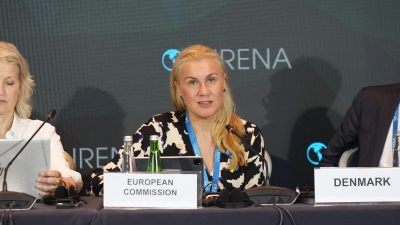Europe needs an investment plan to win the global cleantech race

The adoption by the US of the Inflation Reduction Act gave new life to the global cleantech race. The EU must now learn three lessons from it, writes Thomas Pellerin-Carlin.
As anyone who has marvelled at professional cyclists vying for position knows, the decisions competitors take challenges the strategy of those following close behind.
Since August 2022, when the US Congress adopted a public climate investment plan of $400-800 billion as part of the Inflation Reduction Act (IRA), it’s safe to say the global cleantech race has moved up a gear.
The debate over the IRA’s impact on EU competitiveness has occupied policymakers for months. And rightly so – the International Energy Agency estimates the global market for six critical clean technologies will reach 650 billion dollars a year by 2030.
Responding to US efforts on cleantech manufacturing (including solar panels, wind turbines, batteries, and renewable hydrogen) will require the EU to capitalise on its climate policy leadership and develop a long-term investment plan to meet the financing needs of its cleantech industries.
The cleantech marathon
Cleantech investments do pay off. Not only by mitigating climate change but also with jobs and technological leadership.
Decades ago, Denmark invested in developing wind power technologies. Seizing its first-mover advantage, it now leads with a company like Vestas outperforming its US and Chinese competitors, hiring 30.000 workers, and generating €15 billion in annual revenues.
In the marathon that is the global cleantech race, the EU benefits from the most developed set of climate regulations and carbon pricing in the world. However, it lacks the investment plan that China and the US now have on offer.
The next logical step is for the EU to build a long-term investment plan that complements the other pieces of Europe’s net-zero industrial puzzle. Business leaders would also benefit from an EU Investment Plan that delivers a decade of certainty.
Three lessons from the IRA
The EU must learn three lessons from the US Inflation Reduction Act: investing at scale, delivering long-term predictability, and using simple instruments that are easily understood by users.
According to the European Investment Bank, EU climate investments need to increase by an additional €360Bn/year. There is no way to bridge such a gap without additional EU investments at scale. At the very least, in 2023 the EU should focus on scaling its public investment in cleantech, to crowd-in private investments.
Long-term horizons suit capital-intensive cleantech investments. The IRA delivers support schemes for the next ten years. By contrast, current EU funding streams, such as NextGenerationEU, only offer near-term investment support until 2026.
This is still effective in supporting green public procurement for innovative products and services, but the lack of long-term certainty scares investors.
The IRA offers simple-to-understand instruments, that reward US producers based on the volume of renewable power and hydrogen achieved. It’s this kind of granularity the EU should now be aiming for.
Think like an investor
Let’s say a renewable hydrogen producer chooses Europe today and needs five years for the plant to become operational.
By 2028, NextGenerationEU funds will no longer be available, there is zero visibility on the EU Budget, and only a patchwork of complex subsidies in certain Member States.
On the other hand, if the producer manufactures in the US, the IRA alone guarantees 34$ per Megawatt hour of renewable electricity support (lowering the cost of electricity which is the main input in renewable hydrogen production), and 3$ per kilogram of renewable hydrogen produced over a 10-year period.
Benefits from the IRA exist even if the project is delayed by a few years. This is enough to make the business case, even before accounting for other US federal support schemes, like the 2021 Infrastructure bill and state-level support.
How should the EU respond?
The EU Green Deal Industrial Plan is designed with a four-pillar approach: regulation, investment, skills and trade.
The Net Zero Industry Act that the European Commission will propose on 14 March is the regulatory component and a good basis on which to build an investment plan.
Europe cannot replicate the Inflation Reduction Act, but an EU cleantech investment plan can match the IRA and preserve the solidarity of the single market by limiting emergency exemptions to state aid rules.
To achieve competitive sustainability, the EU should outline detailed plans for competitive funding auctions with various scopes across the supply chain. Small- and large-scale tenders would ensure the EU supports scale-ups, SMEs, and incumbents.
With the approaching EU elections and the end of NextGenerationEU in sight, the EU needs a cleantech investment plan to turn the Green Deal objectives into tangible investments for businesses, workers, and families.



